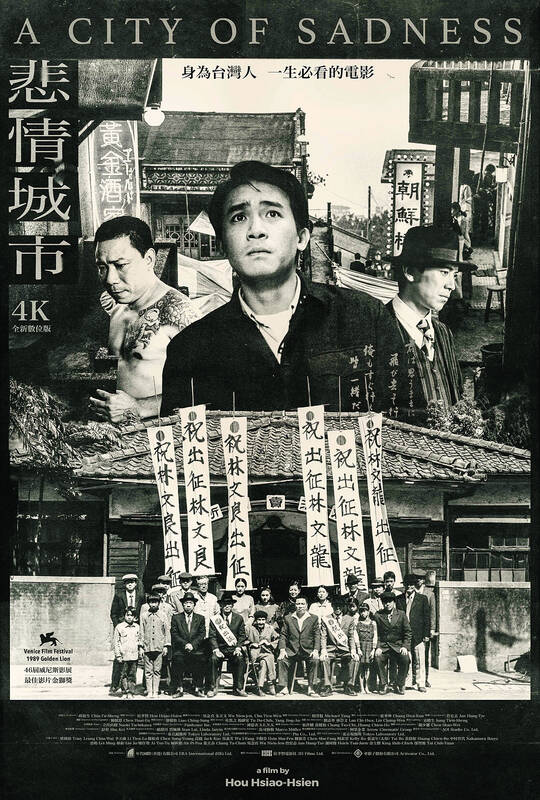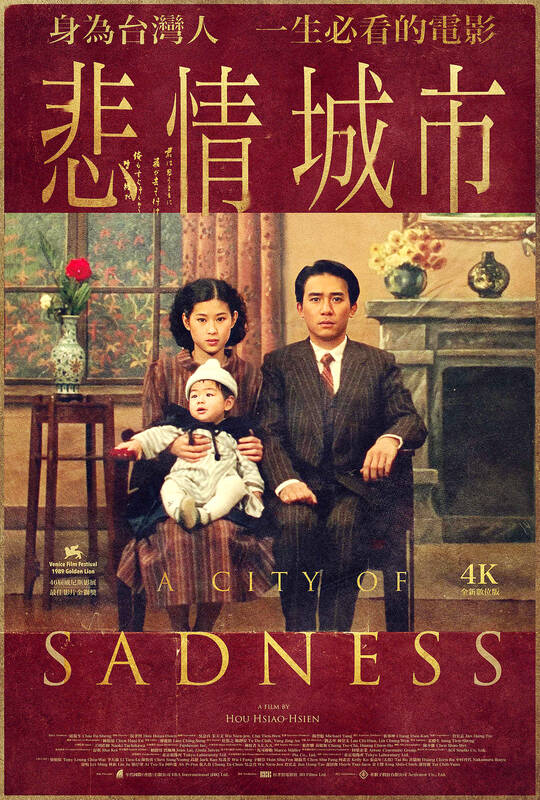A City of Sadness, the 1989 film, directed by the renowned director Hou Hsiao-hsien and based on a story during the 228 Incident, has been re-released after 33 years. With a new poster that reads “A must-see movie for all Taiwanese,” the 4K digital version is being screened in theaters across Taiwan from Feb. 24.
Hou’s A City of Sadness was the winner of the Golden Lion Award for Best Film at the 46th Venice Film Festival in 1989 with its unique visual style and political and historical views, and became the first Taiwanese film to win at one of the three major international film festivals.
It was 10 years after the US cut diplomatic ties with Taiwan in 1979, and Taiwan had become “the orphan of Asia.” During the 1989 Venice Film Festival, due to political interference from China, Taiwan’s national flag was not allowed to be hung outside the Festival venue along with those of other shortlisted films’ countries, leaving Taiwan’s flagpole empty. Despite that, the win made Taiwan’s name and story appear in major media around the world following the success at the film festival.

Photo courtesy of Activator Co. Ltd. 照片:牽猴子股份有限公司提供
A City of Sadness was the first film in Taiwan’s movie history to use synchronized sound technology, Hou’s first movie to tackle historical themes, and was the first film or television work to deal with the 228 Incident after the lifting of martial law in Taiwan in 1987.
The winning of the Golden Lion also laid an unshakable cornerstone for the “Taiwan New Cinema” (or Taiwanese New Wave Cinema) movement, which began in 1982.
It is from A City of Sadness, that Hou, who had already established his signature aesthetics of the “long take,” started to abandon the script during shooting, instead allowing the actors to make their own interpretations. Writer, film producer and entrepreneur Jan Hung-tze recalls that Hou did not show the script to amateur actors, so as to avoid rigid and unnatural acting. Hou described the character’s life and story to the amateur actors on the set, instead of asking them to memorize the dialogue in the script.

Photo courtesy of Activator Co. Ltd. 照片:牽猴子股份有限公司提供
In order to prevent actors from various backgrounds from “acting too hard” in front of the camera, Hou also began to “cheat” his actors, pretending to be rehearsing on the set of the film, but in fact taking advantage of their most relaxed moments to capture the most natural performance. This filming method earned Chen Sung-young the Best Actor of the Golden Horse Awards with his performance in the film.
(Translated by Lin Lee-kai, Taipei Times)
名導侯孝賢執導的「悲情城市」相隔33年重映,電影以二二八事件為背景,新款海報寫上「身為台灣人,一生必看的電影」,4K數位版於2月24日全台上映。
侯孝賢的「悲情城市」憑藉獨特的視覺風格與政治歷史觀點,在1989年摘下第46屆威尼斯影展最佳影片金獅獎,也成為台灣首部在世界三大影展獲獎的國片。
儘管那是1979年台美斷交的10年後,台灣在國際間地位如同「亞細亞的孤兒」,1989年的威尼斯影展,也因中國政治干預,場外懸掛入圍影片國家的旗杆上,原該懸掛中華民國國旗,卻是空空蕩蕩;但獲得金獅獎的《悲情城市》,仍讓台灣的名字、故事,隨著影展捷報,出現在全世界各大媒體。
它是台灣電影史上第一次採用同步錄音技術拍攝的電影,也是侯導第一次挑戰歷史題材,更是台灣在1987年解嚴後,第一部敘述二二八事件的影視作品。
《悲情城市》獲金獅獎,也為從1982年開始的「台灣新電影」運動,奠定了難以撼動的崇高地位。
彼時已確立長鏡頭美學的侯孝賢,也是從《悲情城市》開始,在現場漸漸捨棄劇本,讓演員自己發揮。詹宏志就曾回憶,侯導不給非演員看劇本,以免照本宣科。侯孝賢在拍攝現場是以口頭向非演員描述角色的生平、故事。
為了避免各種背景的演員,在鏡頭前演得太用力,侯孝賢也開始「騙」他的演員,在拍片現場假裝試戲,其實是趁他們最放鬆的情形下,拍下最自然的表現。這個拍法,也讓陳松勇以本片榮獲金馬獎影帝。
(中央社)

China commemorated 80 years since the end of World War II last week with a massive military parade against a backdrop of a disputed history about who ultimately defeated Japan. The issues, including Japan’s reckoning with its wartime record in China, are bound to flare again in December, a flashpoint anniversary of the mass killing in Nanjing by invading Japanese troops. Below is an explainer about what the different — and disputed — points of view are. WHAT IS CHINA’S VIEW? For the Chinese government sitting in Beijing, this is a clear-cut issue: China sacrificed 35 million people in a heroic and brutal struggle

Rarely does Nature present such a striking contradiction as the one found in Lencois Maranhenses National Park. Located along Brazil’s northeastern coast, the park unveils breathtaking scenery, where rippling sands meet crystal-clear lagoons. Under the sun’s golden glow, the waters glitter in shades of turquoise and emerald. So surreal is this spectacle that visitors might wonder if they’re gazing at a digitally modified photo rather than a living landscape. Were it not for the unique geographical and climatic conditions, such a marvel would not exist. Unlike typical deserts, Lencois Maranhenses receives a substantial amount of rainfall, particularly during the rainy season

In a major step to combat carbon emissions, Norway’s pioneering “Northern Lights project” is set to expand its carbon capture and storage (CCS) capabilities. Backed by energy giants and the Norwegian government, this collaborative project is working to increase its annual carbon storage capacity from 1.5 million to over five million tons. Northern Lights focuses on capturing CO2 emissions from industrial sources across Europe and securely storing them underground. Captured CO2 will be liquefied and transported by ship to the storage facility located off the coast of Norway. It will be injected through pipes into geological formations about 2,600m below the

1. 我和他相識已經九個月了。 ˇ He and I have known each other for nine months. χ I and he have known each other for nine months. 註:單數的不同人稱代名詞連用,其次序一般是 you and I、you and he、he and I、she and I。複數人稱代名詞的次序是 we and you、you and they、we, you, and they。 2. 我自己不願意去那家公司工作。 ˇ I myself am unwilling to work in that company. χ Myself am unwilling to work in that company. 註:myself、yourself、himself、herself、itself、ourselves、yourselves、themselves、oneself 等反身代名詞可用來加強語氣,但必須跟在其所加強的人之後,不能單獨出現當作代名詞用。 I myself went there. I’ll do it myself. He did it himself. 3. 沒有人知道這件事情。 ˇ Nobody knows about this. χ No body knows about this. 註:nobody 不可寫作 no body;同樣 anybody、somebody、everybody 都不可以分開來寫。說「沒有人」,用 no one 或 none 都可以。 4. 我會把自己的書送給他。 ˇ I will give my own book to him. χ I